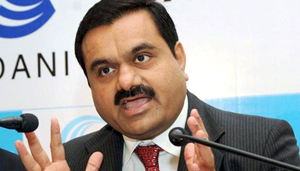Melbourne, Jun 6: Indian conglomerate Adani Group todaygave the final investment approval for its controversy- hit 21.7billion dollars Carmichael coal mine project in Australia which had hit several roadblocks over environmental concerns due to its proximity to the Great Barrier Reef.
"I am proud to announcethe project has Final Investment Decision (FID) approvalwhich marksthe official start of one of the largest singleinfrastructure-- and job creating -- developments in Australia's recent history," Adani Group Chairman Gautam Adani said.
This is a historic day for Adani, a historic day for regional Queensland, andahistoric day for the Indian investment in Australia, he said.
The announcement comes just days after the Adani Group agreed to pay royalties on coal produced from its project after it struck an agreement with the Queensland government to help the controversy-hit project move forward.
"Thisisthe largest single investment by an Indian corporation in Australia, andI believeotherswill followwithinvestments and trade deals," the Adani Group Chairman said.
"We have been challengedby activists in the courts, ininner citystreets,and even outside banks thathave noteven been approachedto financetheproject. We are still facingactivists. But we are committed to this project," Adani said, adding that the group is committed to Queenslandand to addressing energy poverty in India.
Adani said the Carmichael projects will generate 10,000 direct and indirect jobs,with pre-construction works starting in the September Quarter 2017.
Queensland Premier Annastacia Palaszczuk today officially opened Adani's Regional Headquarters (RHQ) in Townsville fromwhere the companywill oversee theconstruction and operations of theproject.
The regional headquarters will also accommodate Adani's Remote Operations Centre, the first time that such a centre has been set up in an Australian regional city.
PrimeMinister Malcolm Turnbullwas represented at the ceremony bythe Federal Minister for Northern Australia and Resources, Senator Matt Canavan.
Adani Australia Head of Country and Chief Executive Jeyakumar Janakaraj saidthe companyhasalready invested 3.3 billion dollars in the project, including buying the bulk coal handling port ofAbbot Point.
Adani today also signed letters of awardfordesign, construction, operations, the supply ofmaterialsandprofessional services.
The biggestdealis withDownerMiningfor the construction and operation of the Carmichael mine.
The company hasalso announced in the past few weeks contracts totalling more than 150 million dollars for the railway tracks and concrete sleepers for the planned388- kmstandard gaugerail link between the mine and Abbot Point.
Importantly, these contracts had gone to regional cities to generate jobs -- 74 million dollars for railway tracks (Arrium Steel, Whyalla) and 82 million dollars for sleepers (Austrak, Rockhampton).
Janakaraj also announcedanother contract for the CarmichaelRail Network linkingGalilee Basinmines, including the Adani mine,tothe port ofAbbot Point.
This contract iswith AECOM,who are regionally based in Townsville.
The AECOM deal coverssurveying anddesignfor the rail linkwith the company basing 70 people in Townsville.
"But we are building more than a rail line," Janakaraj said.
"We are building a line that will open the Galilee Basin, linking that massive coal reserve to markets around the world, generating power, and -- importantly -- generating many thousands of direct and indirect jobs in regional Queensland," Janakaraj said.
In Adani's case, it will linkitsCarmichael coal mine to its bulk loading facility atthe port ofAbbot Point from where it will be shipped to Adani's power stations in India. While some may be looking for ways to leave regional Queensland, Adani is looking to the future, he said.
"We are looking to ensure regional Queensland remains a great place to live, work and to raise a family. To achieve that, Adani is delivering onitspromise to address power poverty for hundreds of millions in India and unacceptably high unemployment in regional Queensland," he added.
"To those activists who sit in creature comfort and criticise us, I ask a simple question -- what are you doing for those people?" Janakaraj said.
Meanwhile, a group of religious leaders camped out today at the Sydney-based Commonwealth Bank's headquarters to protest against the proposed Adani mega coal mine project.
Local media reported that ten Buddhist and Christian leaders rallied outside the Darling Harbour office, holding signs with messages including 'People of faith say rule out Adani' and 'Grandpa what did you do about global warming?'
Uniting Church Minister Rex Graham said the group was opposed to the expansion of coal mines in Australia.
"The other banks have heard the message, particularly National Australian Bank and Westpac, and that's what we're looking for the Commonwealth Bank to also do so," he was quoted as saying.
The Carmichael coal project, Australia's largest, has been delayed since first being proposed in 2010 due to protests by green groups over its environmental impact.
The Indian energy giant has for more than five years battled the opposition to any expansion of the Abbot Point port, saying it will cut into the Great Barrier Reef World Heritage Area.
The project involves dredging 1.1 million cubic metres of soil near the Great Barrier Reef Marine Park, which will then be disposed of on land.
The Adani Group entered Australia in 2010 with the purchase of the greenfield Carmichael coal mine in the Galilee Basin in central Queensland, and the Abbot Point port near Bowen in the north.





Comments
Add new comment